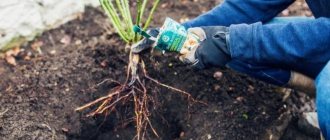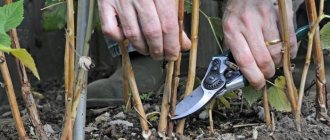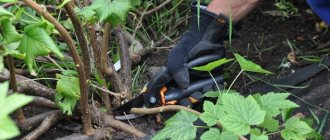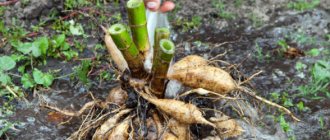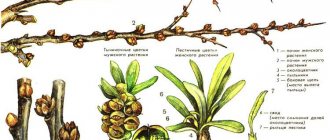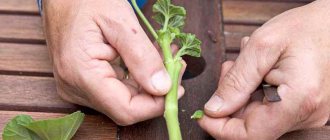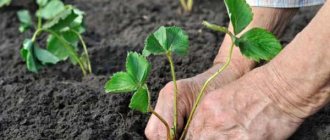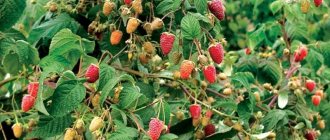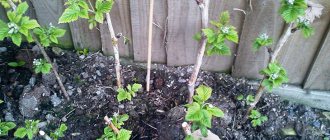Method one: root suckers
The raspberry root system quickly grows away from the mother bush like a weed. Buds form on the roots, from which young shoots grow. Reproduction by offspring is considered one of the most effective methods - the survival rate of plants is 70-100%.
Reproduction by lignified offspring
Lignified shoots are dug up in September before the leaves begin to fall. Then they will have enough time to get stronger before the cold weather arrives.
For propagation, choose strong and strong seedlings that germinate at a distance of 35 cm from the core bush. Dig them out carefully so as not to damage the rhizomes. The optimal length of the roots is from 12 to 15 cm. There should be no swelling, growths or spots on them. These are all signs of diseases that spread quickly during transplantation.
Root shoots are replanted immediately after digging. Their tops are cut off to stimulate growth, and the shoot height is kept within 18-20 cm. If there are leaves, they need to be cut off. Don't forget to water and mulch the bed.
Reproduction by green offspring
Green root shoots are transplanted in April, when their height reaches 15 cm. It is better to do this on a cloudy day so that moisture is better retained in the young seedlings. You can first grow them in a separate bed, and transplant them to a permanent plot in the fall.
Shoots are selected according to the same principle as lignified offspring. Pay attention to the condition of the tops - they should be healthy. Lethargy indicates infection with a raspberry fly.
The holes for green offspring are filled with organic matter with the addition of a tablespoon of wood ash. Mulch and abundant watering are required.
Soil preparation
To always have a large and tasty harvest, plant raspberries in an area that is well lit by the sun, but at the same time protected from drafts and cold winds.
Raspberries do not like acidic soils and cannot tolerate high standing water. It is best to choose light soils, loam. Otherwise, the composition of the soil will have to be compensated with mineral and organic fertilizers, ash, and dolomite flour.
Since this is a perennial plant and it is replanted quite rarely, approximately in the 15th year of life in the same place, then depending on how high-quality the soil is under the berry garden, how quantitative the harvests will be. Important points:
- Raspberry roots are located approximately 30 cm deep into the ground, so for their good development, the soil, of course, should be enriched with nutrients and the necessary moisture.
- The soil should be loose and structural, then sufficient oxygen will penetrate into it for good rhizome growth.
- In addition, the soil must be perfectly permeable to moisture and bring it to the roots. Clay and very crumbly soils, in which there is nothing nutritious, very often “kill” raspberries, and, accordingly, they do not produce any harvest.
More on the topic: Choosing the right raspberry seedling for planting
If this is the kind of soil you have, then you should fertilize it well before planting new seedlings. It is necessary to apply approximately 10 kg per 1 m2 of organic fertilizers for better growth and good taste of raspberries.
Places for planting plants should be chosen with a flat surface that is protected from the wind by buildings, a fence or other large plantings. Before planting raspberries, the soil is deeply plowed and at the same time fertilized with compost, which was prepared in advance.
Compost is easy to make from household waste that accumulates in every home. These can be ordinary food scraps, vegetable peelings, weeds, wood waste, fallen leaves.
Method two: cuttings
Cuttings are parts of a plant that, when planted in a substrate, form roots and buds. Cuttings are a popular method of propagating varietal raspberries.
Propagation by lignified cuttings
Preparation of planting material begins in the fall. Raspberry shoots are cut off and divided into parts. The approximate length of the cuttings is 25 cm. They are wrapped in cloth, placed in a box with damp sand and sent to the cellar until the end of winter.
In February, the preparation of planting material begins. The algorithm of actions is as follows.
- Soak the cuttings in water for 12 hours, after cutting off the ends.
- Dissolve a teaspoon of honey in a liter of water. This solution will stimulate root growth. We place the cuttings in it for 30 days - approximately this is necessary for the formation of a young root system.
- When the roots reach a centimeter in length, the cuttings will be ready to be transplanted into pots with soil. You can use plastic bottles with the top cut off. Fill them with soil, make holes, plant cuttings there and sprinkle with sand.
- We maintain soil moisture, but do not flood it to avoid rot.
- After three weeks, the seedlings will develop a root system and produce leaves. At the beginning of May they are ready to move into open ground.
Cuttings are the most effective way to propagate yellow raspberries.
Propagation by root cuttings
Such cuttings are prepared from roots dug at a distance of 35-40 cm from the core bush. You need the strongest horizontal parts with a diameter of 2-5 mm. They are cut into 10 cm pieces, with one or two buds on each.
Root cuttings are planted in a greenhouse or hotbed in soil enriched with humus. In the garden bed, make grooves 5-6 cm deep, lay out planting material in them and fill them with loose soil. There is no need to make gaps between cuttings. In autumn, young bushes are transplanted into the ground.
You can harvest root cuttings in the fall. In this case, they are stored in the basement, in a container with wet sand, until April.
Propagation by green cuttings
In this way, the shrub is propagated only in summer, since green cuttings are stored in the refrigerator for no more than 48 hours. Use the parts left over after trimming the raspberries. Shoots 8-12 cm long with two or three leaves are suitable.
The next step is soaking in a growth stimulator solution. Tie 10-12 stems with a thread and dip their ends in a 0.1 percent Heteroauxin solution for 16 hours. Another option is Kornevin’s solution, prepared at the rate of 1 tsp. for 1 liter of water. The cuttings are left in it for 12 hours.
Prepare the bed in a greenhouse or hothouse. The best environment for the development of seedlings is a mixture of peat and sand. It will take a month and a half for the cuttings to root - after which they will be ready to move into the garden in the open air.
Method three: layering
Layerings are the tops of long raspberry stems that have bent toward the ground and developed their own roots. They are cut off from the mother bush in the spring and moved to a new site along with a lump of earth.
Reproduction by horizontal layering
To form horizontal layering, furrows are dug away from the mother plant, like rays from the center. Depth - 10 cm. The bottom is covered with sand, and the stems are laid on top of it and secured with wire staples. All side branches and stem tips must be trimmed. We fill the top with soil and water it with Kornevin’s solution at the rate of 5 g per 5 liters of water. After 20 days, water again.
The cuttings will develop roots by late summer. In the fall, they are separated from the core bush and moved to another place.
Reproduction by apical layering
By May, raspberries grow long and flexible stems, which are used for layering. They pinch off the tops and bend them to the ground to the dug furrows. The furrows are prepared according to the following scheme.
- The soil is loosened next to the mother bush and peat and sand are added to it.
- Dig furrows 10 cm deep. Branch stems are inclined towards them and fixed with staples.
- Sprinkle with soil and water generously.
In September, the cuttings are cut off from the bush and transplanted to a prepared area.
Cumberland black raspberries propagate well this way.
Where do raspberries grow?
Transplanted raspberries should not be adjacent to garden trees
Professionals, as an example of a suitable place, call planting shrubs along the fence on the south or southwest side of the garden. In this case, care should be taken to ensure that no fruit trees grow nearby. Also, there should be no potatoes, strawberries or tomatoes near the seedlings. These crops have similar pests and diseases to this plant. Gardeners with experience name gooseberries and chokeberries as the best predecessors for berry seedlings.
When choosing a place for transplantation, you must remember that the shrub does not tolerate low wetlands. It is better to give preference to slightly raised and flat areas . Sandy soils are suitable only with constant watering in the summer. Raspberries should not be transplanted near dirt roads, as they generate a lot of dust.
Method four: dividing the bush
From one raspberry bush you can make 3-4 daughter ones if you propagate it by division.
- In spring, dig up the entire plant, being careful not to damage the underground part.
- Divide into several parts and cut the stems to 20 cm. You can shorten them after replanting.
- Mix sand, peat and soil in a 1-1-3 ratio. This will be the soil for backfilling.
- Plant the daughter bushes in holes 35-40 cm deep and fill them with prepared soil.
- Water thoroughly.
In order for the daughter bushes to take root in a new place, do not forget to feed them and water them regularly throughout the season. Then there will be berries next year.
Seedling care
After spring planting, it is necessary to pay attention to the care and development of young shoots.
This subshrub is responsive to mulching in the first 2–3 years of its active growth. With the help of mulch, not only water, but also heat and air exchange is regulated. The soil is actively saturated with nitrogen, which is necessary for the development of the root system of a young plant.
Raspberries love watering . This fact is known even to novice gardeners. Lack of moisture affects not only the yield of raspberries, but also the taste of the berries. The main watering is carried out in the first half of the summer season, which falls during the flowering and fruiting period. At the end of the harvest season, watering is reduced to a minimum.
The raspberry bush should be watered in a timely manner.
First pruning of transplanted seedlings
The first pruning is done during the period of active growth.
After harvesting, you need to remove all dried stems.
This stimulates the development of the subshrub. When the height of the seedlings reaches 1 meter, weak and frozen shoots are inspected and pruned. Such actions help to increase the size of the berries during the first fruiting period.
After the end of the harvest season, all dried stems and shoots are removed. Thus, the light and air conditions for annuals are regulated.
Young bushes
Young bushes require support, especially during the period of berry ripening. Often branches break or are pressed too tightly to the ground, thereby worsening phytosanitary conditions.
It is recommended to strengthen young raspberry shoots to the trellis.
The most convenient way to support a raspberry tree is a traditional vertical trellis, well known since the Soviet period in dacha gardens.
Method five: nettle
Nettle is a young herbaceous shoot of raspberry, similar in shape to ordinary nettle. Nettles are used to propagate remontant raspberries and capricious varieties like Tarusa.
Read more about raspberry varieties in a separate article.
In the spring, when young shoots appear, the soil is carefully raked away from them and the stems are cut off along with their white underground parts. The cut ends are treated with Kornevin. Prepare a mixture of equal parts of sand and peat and plant nettles in it. After abundant watering, the shoots are covered with plastic bottles to create a greenhouse effect.
It will take up to four weeks for the seedlings to develop a strong root system. After this, they can be transplanted into an open garden bed.
Watch a video about propagating raspberries with nettles.
Autumn transplantation of raspberries
Raspberries should be replanted in the fall well before frost.
Transplanting raspberries in the fall is necessary to increase yield. The bushes are rejuvenated, and the quality of the harvest is not lost. Experienced gardeners advise carrying out work from mid-September to October. When the characteristics of regions are taken into account, the timing may not coincide. In this case, the primary condition is that from planting raspberry bushes to the first frost, a period of a month is needed. During this period, the plant will be able to take root and settle down on the site. There is no need to replant in late autumn .
Experienced gardeners call the dates relative to the regions. Replanting seedlings in the south is required from the end of September to the twentieth of October. In the center and north, this work should be carried out in the first ten days of September. It is also better for the gardener to take weather conditions into account. In this case, you should constantly monitor the temperature.
Raspberries should be replanted very carefully, without damaging important parts of the plant.
Experts call autumn the optimal time to replant shrubs. They can overwinter well if the timing and planting technology are followed. It has been noticed that such seedlings will grow quickly in the spring, ahead of those planted in the spring. Caring for bushes in the fall is not difficult, since the weather conditions are devoid of heat, which occurs in the spring and does not allow seedlings to take root.
Method six: Scottish method
Gardeners speak well of this method, calling it very effective. The algorithm of actions is as follows.
- In the spring, we dig up the ground around the mother bush, adding peat, sawdust and humus to it in equal proportions. Thanks to this, buds will begin to actively appear on the rhizomes.
- In the fall we make cuttings and store them in damp sand in the basement.
- In March, we plant the planting material in boxes with a sand-peat mixture, water it and wait for the shoots to start growing. This takes about three weeks.
- Preparing the soil in pots for seedlings. We will need turf, sand, peat in a ratio of 3-1-1. Mix and add superphosphate and dolomite flour to the soil in quantities of 5 g and 50 g, respectively. These are the proportions for 100 g of prepared soil.
- After 30 days, we move the seedlings to the garden in the open air.
Method seven: seeds
Harvesting and planting raspberry seeds is a labor-intensive and complex process, so it is rarely used. Rare and valuable varieties are mainly propagated in this way.
The best seedlings are obtained from the seeds of ripe and overripe fruits. The berries are wrapped in gauze and the juice is squeezed out of them. Then rinse and leave for 24 hours in a mug of water. The next day, mix it with raw sand, put it in cloth bags and put it in a cool basement for three months. In the basement they are stored in boxes with moss, moistening it every two weeks.
[Alt: Harvesting raspberry seeds]
In March of the next season, seedling harvesting begins. The grains are sown in a container with soil, deepened by 3-5 cm. Sprinkled with sand, covered with a transparent film and placed in a warm place, protected from direct sunlight. Every three days the soil is moistened.
After the first true leaves appear, hardening begins. Within a week, the seedlings are taken outside. For the first time – for 60 minutes. With each subsequent day, the time for “walking” the seedlings is increased by an hour. After a week, it can already be left outside for the whole day.
In May, the seedlings are ready to move into the garden. They are planted in holes 12-15 cm deep along with a lump of earth, watered and covered with film for 30 days. The first harvest is obtained after two years.
